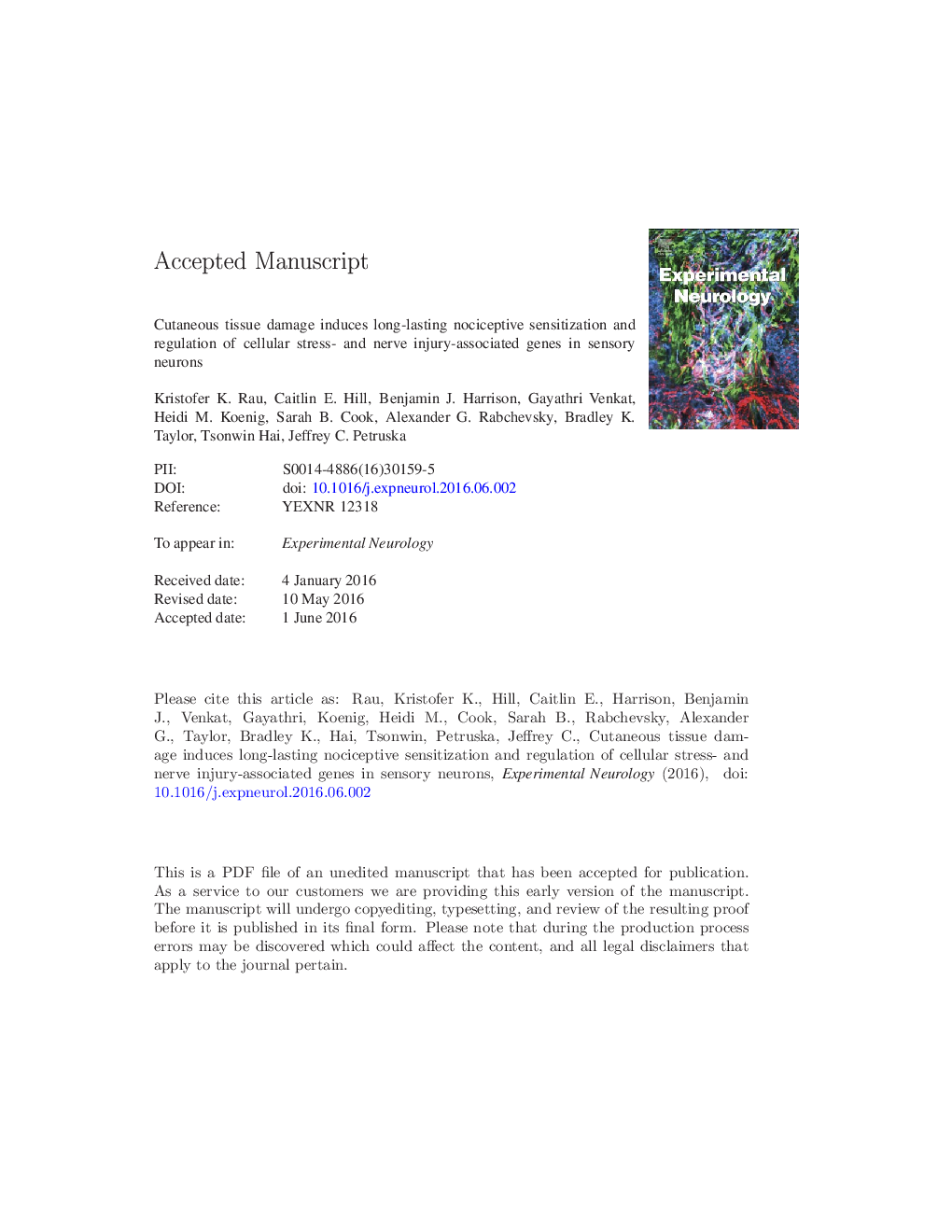| کد مقاله | کد نشریه | سال انتشار | مقاله انگلیسی | نسخه تمام متن |
|---|---|---|---|---|
| 6016933 | 1186470 | 2016 | 58 صفحه PDF | دانلود رایگان |
عنوان انگلیسی مقاله ISI
Cutaneous tissue damage induces long-lasting nociceptive sensitization and regulation of cellular stress- and nerve injury-associated genes in sensory neurons
ترجمه فارسی عنوان
آسیب بافت پوستی موجب حساسیت طولانی مدت حساسیت و تنظیم سلول های ژنی مرتبط با استرس و عصب سلولی در نورون های حسی می شود
دانلود مقاله + سفارش ترجمه
دانلود مقاله ISI انگلیسی
رایگان برای ایرانیان
کلمات کلیدی
گانگلیون ریشه پشتی، درد، عفونی آسیب بافتی استرس سلولی،
موضوعات مرتبط
علوم زیستی و بیوفناوری
علم عصب شناسی
عصب شناسی
چکیده انگلیسی
Tissue damage is one of the major etiological factors in the emergence of chronic/persistent pain, although mechanisms remain enigmatic. Using incision of the back skin of adult rats as a model for tissue damage, we observed sensitization in a nociceptive reflex enduring to 28Â days post-incision (DPI). To determine if the enduring behavioral changes corresponded with a long-term impact of tissue damage on sensory neurons, we examined the temporal expression profile of injury-regulated genes and the electrophysiological properties of traced dorsal root ganglion (DRG) sensory neurons. The mRNA for the injury/stress-hub gene Activating Transcription Factor 3 (ATF3) was upregulated and peaked within 4 DPI, after which levels declined but remained significantly elevated out to 28 DPI, a time when the initial incision appears healed and tissue-inflammation largely resolved. Accordingly, stereological image analysis indicated that some neurons expressed ATF3 only transiently (mostly medium-large neurons), while in others it was sustained (mostly small neurons), suggesting cell-type-specific responses. In retrogradely-traced ATF3-expressing neurons, Calcium/calmodulin-dependent protein kinase type IV (CAMK4) protein levels and isolectin-B4 (IB4)-binding were suppressed whereas Growth Associated Protein-43 (GAP-43) and Neuropeptide Y (NPY) protein levels were enhanced. Electrophysiological recordings from DiI-traced sensory neurons 28 DPI showed a significant sensitization limited to ATF3-expressing neurons. Thus, ATF3 expression is revealed as a strong predictor of single cells displaying enduring pain-related electrophysiological properties. The cellular injury/stress response induced in sensory neurons by tissue damage and indicated by ATF3 expression is positioned to contribute to pain which can occur after tissue damage.
ناشر
Database: Elsevier - ScienceDirect (ساینس دایرکت)
Journal: Experimental Neurology - Volume 283, Part A, September 2016, Pages 413-427
Journal: Experimental Neurology - Volume 283, Part A, September 2016, Pages 413-427
نویسندگان
Kristofer K. Rau, Caitlin E. Hill, Benjamin J. Harrison, Gayathri Venkat, Heidi M. Koenig, Sarah B. Cook, Alexander G. Rabchevsky, Bradley K. Taylor, Tsonwin Hai, Jeffrey C. Petruska,
